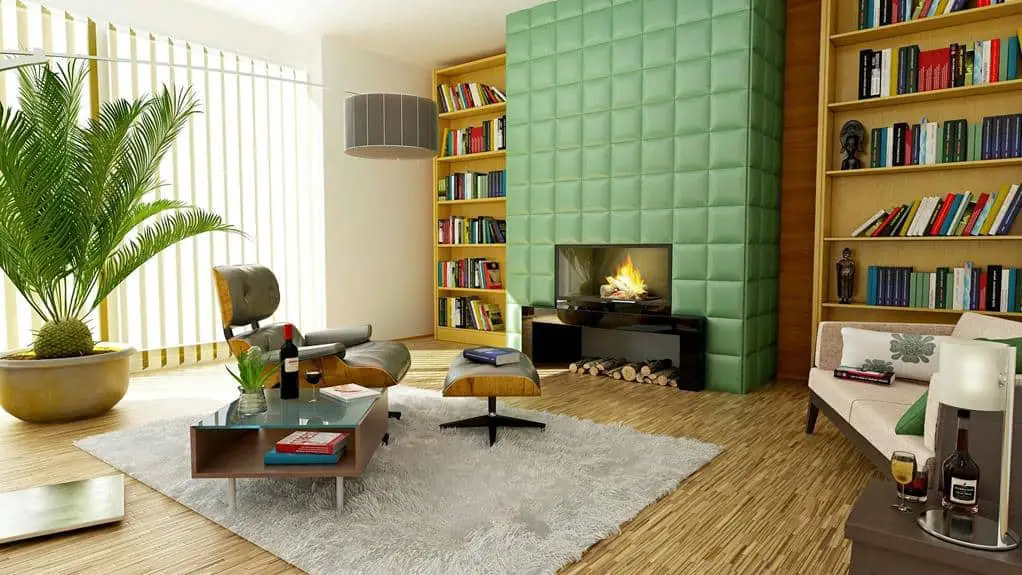When deciding whether a fireplace mantel should match the room's trim or floor, consider the overall design style. Matching the mantel with the trim can create a traditional and unified look.
Matching it with the floor can provide a sense of balance.
The decision should factor in color, proportions, and style to enhance the room's appearance.
It may be helpful to consult a professional for guidance.
Understanding Mantel Aesthetics
The color and design of a mantel significantly influence a room's aesthetic. A mantel matching the room's trim or flooring can unify the space and create a cohesive look. In contrast, a mantel with contrasting colors or designs can serve as a focal point, adding depth and interest to the room.
A fireplace serves as a central design element, and its mantel should be carefully selected to either blend with the room's existing style or stand out as a distinct feature, depending on the desired effect. The decision to match or contrast the mantel with the room's other elements is based on the intended ambiance and overall design goals.
The mantel's relationship with the trim and floor is important in achieving a cohesive interior. Matching the mantel to the floor molding can visually expand a small room, while a contrasting mantel can help define different areas in an open floor plan.
Individual preferences and the desired room atmosphere are key factors in the decision-making process. Consulting interior designers or fireplace specialists can provide customized recommendations. Ultimately, the choice of mantel color and design should intentionally enhance the room's overall theme and contribute to a welcoming space.
Pros of Matching Trim
Matching a fireplace mantel with the trim in a room improves the overall visual harmony of the interior design. It creates a consistent look that ties together different elements in the space. For example, painting a wood mantel to match the trim's semi-gloss acrylic paint provides a unified theme. This can make the fireplace stand out as a central feature without being overpowering.
Having the mantel and trim match also simplifies the design process by reducing the number of choices to be made. It can make maintenance easier too, as the same cleaning and touch-up methods can be applied to both. This ensures they wear evenly and stay looking good over time.
Furthermore, a matching mantel and trim can give the illusion of a larger, more open room by avoiding a cluttered look from too many differing design elements. This can help create a more cohesive and welcoming environment.
Cons of Matching Trim
Matching a fireplace mantel with the room's trim can create a consistent look, but it may also lead to a lack of design flexibility and could result in a space that appears too uniform, potentially diminishing depth and visual interest. This uniformity might not suit everyone's taste.
One downside of matching the trim with the mantel is that it can cause the mantel to blend into its surroundings, failing to emphasize its architectural significance. Additionally, if the trim color does not complement the overall color scheme or desired style, replicating it for the mantel may be counterproductive.
Achieving an exact match between the mantel and the trim can be challenging due to variations in shades or material finishes. This could result in a mismatched appearance or necessitate custom work, which can be expensive and require more effort.
In contrast, a mantel that stands out can be a compelling element in contemporary or eclectic decor, providing visual interest and depth that might be lacking with a matching mantel. The choice between matching and contrasting the mantel with the trim depends on personal preference, but it is vital to be aware of the potential drawbacks of matching.
Considering Floor Harmony
When deciding if a fireplace mantel should match the floor, it's important to think about the visual impact and design unity of the room. Matching the mantel to the floor can enhance the room's appearance and create a cohesive look. For a more coordinated space, aligning the mantel with the floor molding is beneficial. This can lead to a better visual experience, which is key in high-quality interior design.
People decorate their homes to express their personal style. A brick fireplace can add a rustic touch, but it should complement the flooring to improve the overall look. Matching the mantel's material and color with the floor can make the fireplace stand out more. However, if the goal is to draw attention to the fireplace, using contrast can work, as long as it doesn't clash with the room's design.
Choosing the right colors and textures for the mantel and floor involves looking at the overall design. It's not just about matching; each element should enhance the other. Think about how different materials will look together over time and what maintenance they will require. Getting professional advice can help homeowners make choices that create a balanced and cohesive look that fits their vision for their home.
Making the Final Decision
The decision to coordinate a fireplace mantel with the room's trim or flooring depends on aesthetic harmony and practicality. When deciding, one must consider the overall balance of the room. Matching the mantel to the trim or floor can create unity and order in the space.
It is important to think about the durability and upkeep of the materials. A mantel that matches the flooring may be easier to maintain and last longer.
The final choice of matching the mantel to the trim or floor is up to the homeowner and what they want the room to feel like. Some people may prefer a matching mantel for a cohesive look, while others might want a contrasting mantel to add interest.
Consulting with interior designers or fireplace experts can offer personalized advice to ensure the decision is both attractive and practical.




